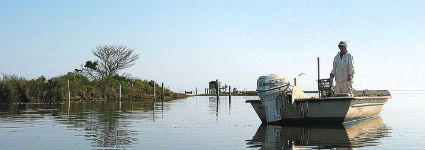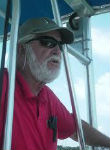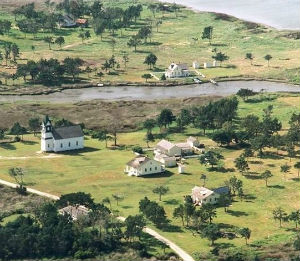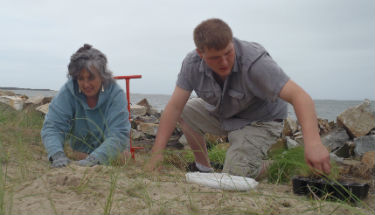 A commercial fisherman works the still waters around Ocracoke Inlet. |
OCRACOKE — Off the coast of eastern North Carolina lies the remote, uninhabited island of Portsmouth, renowned for birds, seashells, surf fishing and history. Getting there from neighboring Ocracoke requires a boat ride through the serene beauty of Ocracoke Inlet. Along the way, you may learn about pirates’ lairs, Civil War forts and an effort to save one of the last remaining brown pelican rookeries in the state.
Part of Cape Lookout National Seashore, Portsmouth Island has beautiful ocean beaches and soundside marshes that stretch its 22-mile length. Superior fishing, beachcombing and shelling await those who visit.
Supporter Spotlight
History also beckons. At its northern end, not far from the island of Ocracoke, stands what is left of a once vibrant and important port. Big sailing ships once stopped there for “lightering.” Their cargo would be transferred to smaller boats that could safely transverse the shallow inlet and Pamlico and Core sounds. Commerce faded and fishing replaced shipping as the primary occupation for the islanders.
The U.S. Life-Saving Service opened a station on Portsmouth in 1894, which played a vital role in the community for 50 years. Steadily the population declined, though. Only 17 residents lived on the island in 1956. The last two left in 1971.
The National Park Service took over the island when the seashore was created five years later. Now a ghost town, the village is maintained as a cultural resource, with a visitors’ center and public access to the old church, the lifesaving station and several of the old homes.
 Rudy Austin |
There is no state ferry service to the old village on the northern end of Portsmouth, but Austin Boat Tours, owned by brothers Rudy and Donald Austin, carries passengers from Ocracoke to Portsmouth on a regular basis. The Austins captain two 24-foot skiffs, each capable of carrying up to 15 people. The ride to Portsmouth takes about 15 to 20 minutes, but it is much more than just a boat ride. The Austins, who grew up on Ocracoke, are a wealth of information about all things related to the islands, and they are more than happy to share their knowledge. Don’t expect a canned speech, though. The Austins are born storytellers, and they entertain their customers with their wit and knowledge.
Rudy, the elder brother, explains that their father, Junius Austin, began the business years ago. He had, for 20 years, been the caretaker of the Portsmouth Life-Saving Station, which became a hunting and fishing club after it closed. Junius sometimes took people to Portsmouth in his skiff, but business increased and prospered after the seashore was established. Rudy and Donald took over the business after their father died. Rudy’s son, Wade, sometimes helps out.
Supporter Spotlight
 Deserted Portsmouth Village offers a taste of life long ago on North Carolina’s barrier islands. Photo: Friends of Portsmouth Island |
Now they run the boats seven days a week in the summer, weather permitting, and on demand at other times. “But I’m not going over in any thunder squalls,” Rudy said emphatically.
They also take out school and church groups, sometimes using both boats. At the end of December each year they transport assorted bird watchers to the island for the annual Christmas bird count, a nation-wide citizen-science bird monitoring project.
“They’re an interesting group,” says Rudy. “Some come from as far away as Michigan.”
Every other year the brothers ferry people across for the Portsmouth Homecoming, sponsored by the Friends of Portsmouth Island. A lot of people go, including the descendants of the residents who once lived there. “It’s a great way to encourage young people to get involved,” Rudy notes.
As the boat leaves Silver Lake Harbor in Ocracoke, the captain might mention that the harbor, then known as the “Creek,” was shallow and unnavigable before the Navy dredged it for its ships in World War II. He might follow up by describing what happened when the war came to the Outer Banks, with German submarines attacking merchant ships in plain sight of the islanders.
Then he’ll point out Hog Shoal, alive at low tide with a variety of water birds. He may steer the boat close to Beacon Island, famous for the number of brown pelicans, terns, and other sea birds which nest there each spring. The island is itself rich with history, having been the site of the Civil War fort, Fort Ocracoke, which was burned by federal troops in 1861. Erosion from storms has eaten away at the island, and it is now the focus of a joint project by the N.C. Coastal Federation and Audubon North Carolina, which are using oyster shells to build a protective reef around it. James Barrie Gaskill, an Ocracoke native and a federation board member, is leading the effort.
A brown pelican watches over her chicks on Beacon Island, one of the last pelican rookeries in the state. Photo: Todd Miller |
 Volunteers plant grasses to restore the salt marsh at Springer’s Point on Ocracoke Island. |
In the distance, you can be seen what is left of Shell Castle, once a significant island in itself. Wharves and warehouses, used by the ships that passed through Ocracoke Inlet, lined its shores. Before the Ocracoke Lighthouse was built in 1823, there was a wooden lighthouse there. The island, which built up around a huge oyster reef, has almost disappeared.
“Things change,” says Rudy. “Everything changes.”
The boat ride may include a swing by Ocracoke’s South Point, with a chance to see Blackbeard’s hideout, Springer’s Point, and Teaches Hole, where he anchored his ship. The 122-acre Springer’s Point Preserve is owned by the N.C. Coastal Land Trust and boasts over a mile of estuarine shoreline, parts of which are eroding because of waves generated across Pamlico Sound and boat wake from a nearby navigation channel. Local people, the land trust and the federation are working to restore the site.
Whatever route it takes, the ride is sure to be interesting and informative. “We try to educate the people on birds, turtles, dolphins, shells, whatever they want to know,” Rudy says
Approaching Portsmouth, the boat slows to navigate the shallow and winding channel. The steeple of the church is visible in the distance, as well as Haulover Dock, now under repair by the Park Service. The captain hands out maps and directions to guide visitors to the beach and the village, with instructions to be back in a little more than three hours. For those who want to go to the beach, Rudy says with a laugh, “I tell them walk to the ocean and turn left. If you turn right, we may not see you again for days!”
To take the ride to Portsmouth Island, book ahead and then come to the dock behind the Ocracoke Waterman’s Exhibit, next to the Community Store in the heart of the village. The round trip ride to Portsmouth costs $20 a person, and the entire excursion lasts four hours. Be sure to bring bug spray and water if the weather is warm, and be prepared for a memorable, rewarding adventure.







